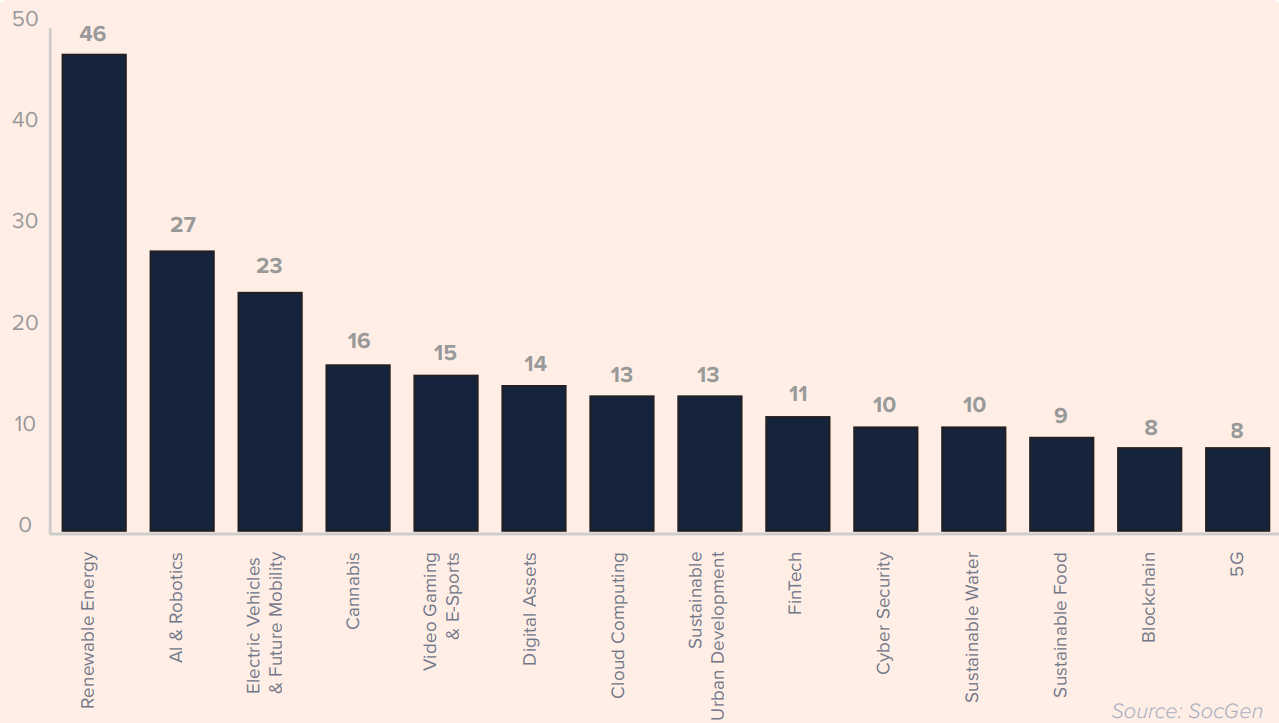Sébastien Lemaire, head of ETF research at Société Générale, has warned there is market-moving potential in the thematic ETF universe.
Speaking at ETF Stream’sBig Call: Thematic ETFs event, Lemaire (pictured) said thematic product usage “increased dramatically” at the beginning of 2020, with more than 120 new launches in Europe since the beginning of the pandemic.
This explosion of new entrants means “thematic indices are now competing for liquidity”, Lemaire warned.
“As an ETF investor, if you want to get exposure to something like renewable energy, you have the choice of 46 indices. EVs, 23. Fintech, 11. Sustainable water, 10,” he continued.
Number of indices per theme

Source: SocGen
The S&P Global Clean Energy index – the world’s second most popular thematic strategy – is only one of 46 benchmark options within its theme but is tracked by five different ETFs domiciled across the world.
When building a thematic index, Lemaire said there are three interconnected “pillars” to consider – purity, an index’s risk-return patterns and liquidity.
With many thematic benchmarks adopting either modified market-cap or equal weight approach, they tend to modify the liquidity profile of the free float market-cap-weighted underlying market.
“For some thematic indices, the number of eligible pure-play stocks may be limited,” Lemaire said. “The risk of purity is to have a limited number of eligible constituents and this is something index providers aim to avoid.
“A limited number of constituents may also lead to index concentration. To reduce this risk, the index provider may create single stock weighting caps, however, those caps tend to overweight smaller or midcaps versus larger caps – they may lead to a lower liquidity profile for the index.”
Should an index that is skewed to smaller companies suddenly welcome large sums of inflows, there is a risk these small players may end up being “materially owned” by ETFs. This also creates moments of significant volatility on index and ETF rebalance days.
“Imagine a stock that is owned 10% by several ETFs tracking the same benchmark,” Lemaire said. “Then imagine the benchmark rebalances and deletes this stock. Brutally, 10% of the market cap of that stock will be sold by the ETFs tracking the benchmark.”
Such a scenario played out as the S&P Dow Jones Indices’ clean energy index saw a “flurry of inflows” during the US presidential election period in 2020. At the start of last year, SocGen noted three ETFs tracking the index together owned more than 10% of Contact Energy – falling to around 2% after S&P changed its index methodology last March.
Before the index provider increased its constituent count to 82 stocks, ETFs tracking the benchmark split their $14bn assets under management (AUM) between just 30 companies. This is significant as liquidity issues can happen with far less money, Lemaire said.
“I have seen some strategies which could cause liquidity problems for the underlying market with only three of five billion dollars invested in them,” he continued. “It all depends on the number of constituents and their size.” These liquidity issues and rebalance events also come at a cost to end investors as opportunistic participants increasingly look to thematic reweightings and the forecastable offloading and buying of stock.
“Traditionally, they were working on predictions and deletions on vanilla indices. But increasingly, the growing part of this industry is focusing on nonvanilla indices that have become very big through ETFs,” Lemaire warned.
On the one hand, hedge funds seeking arbitrage opportunities push up the price of constituents as positions within an index are being opened or enlarged. On the other hand, such activities mean these participants are increasingly becoming key liquidity providers during thematic index rebalances, Lemaire argued.
The last couple of years of thematic growth has been a steep learning curve for investors and index providers alike. It is crucial that in their rush to bring new products to market, ETF issuers consider the trade-off between liquidity, theme purity, diversification and asset gathering as part of their fiduciary duty.
This article first appeared in Thematics Unlocked: Signs of a maturing ETF market, an ETF Stream report. To access the full issue, click here.
Related articles




